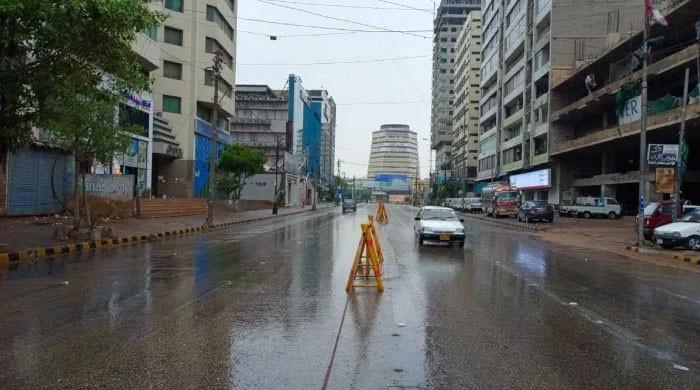Karachi Receives Light Showers, Weather Turns Pleasant
Karachi residents experienced a delightful Sunday morning as light rainfall occurred in the early hours, succeeding several days of cloudy conditions.
Scattered light showers were reported across the city, notably in areas such as the airport vicinity, Malir, Gulistan-e-Jauhar, Shah Faisal, North Karachi, New Karachi, Surjani Town, Gulshan-e-Maymar, Gulshan-e-Iqbal, II Chundrigar Road, PIDC, Saddar, and Burns Road.
The highest recorded rainfall was 2.3 millimetres on University Road, followed by 2mm at the airport, PAF Base Faisal, and Gulshan-e-Hadeed. Korangi and Jinnah Terminal registered 1.4mm of rainfall, while Keamari and Surjani Town saw a minimal 0.2mm.
This rainfall follows the Pakistan Meteorological Department’s (PMD) forecast of moderate to heavy rain with potential thunderstorms in Karachi, with temperatures expected to range between 32 and 34 degrees Celsius.
The Met Office has also indicated that another monsoon system might impact Sindh towards the end of July.
Previously, the Sindh government had cancelled local government holidays and initiated emergency response protocols in anticipation of the expected monsoon rains in Karachi.
Sindh Senior Minister Sharjeel Inam Memon stated that the cancellation of local government holidays was to ensure swift rainwater drainage in vulnerable areas of the city.
The weather system was located over southwestern Uttar Pradesh, India, and was progressing towards Rajasthan. It was anticipated that the system could begin affecting parts of Sindh, including Karachi, by Friday night or later.
If the system continues its westward movement, it could bring substantial rainfall to various Sindh districts. Currently, moderate rain is anticipated in Karachi, according to forecasts. Meteorologists are closely monitoring the system’s path and its potential consequences for southern Pakistan in the coming days.
Across Pakistan, monsoon rains have caused widespread devastation. According to the National Disaster Management Authority (NDMA), at least 202 people, including 96 children, have died in various incidents.
Official data indicates that Punjab has reported 123 deaths. Khyber Pakhtunkhwa recorded 40 deaths, Sindh 21, Balochistan 16, and Islamabad and Azad Jammu and Kashmir each reported one death.
The causes of these deaths include 118 fatalities due to house collapses, 30 from flash floods, and others resulting from drowning, lightning strikes, electrocution, and landslides.
The monsoon rains have also resulted in injuries to over 560 individuals, including 182 children.



Comments (0)
No comments yet. Be the first to comment!
Leave a Comment